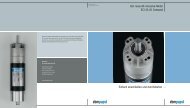Download [PDF] - ebm-papst
Download [PDF] - ebm-papst
Download [PDF] - ebm-papst
Create successful ePaper yourself
Turn your PDF publications into a flip-book with our unique Google optimized e-Paper software.
AC motors<br />
Technical information<br />
EM Shaded-pole motors are of asymmetrical design, have two poles<br />
and feature a squirrel-cage rotor. Motors of this type have a simple,<br />
sturdy design, they are self-starting, require no maintenance and create<br />
no interference.<br />
KM Capacitor motors are two- or four-pole single-phase motors with<br />
squirrel-cage rotors. Their winding is two-stranded and they have an<br />
auxiliary winding connected via capacitor.<br />
Bearings<br />
High quality sintered calotte sleeve bearings with a lubricant depot are<br />
used, suitable for ambient temperatures from approx. 0 to 60°C.<br />
Time-tested bearing systems are also available for lower or higher<br />
temperatures.<br />
With high axial and / or radial stresses, e.g. with vertical shaft positions,<br />
belt drive systems, etc., a bearing design suitable for the required service<br />
life will be needed. Ball bearings may also be used for series EM30.<br />
Ball bearings are standard for capacitor motors.<br />
Direction of rotation<br />
The standard direction of rotation is clockwise, viewed onto drive shaft.<br />
Versions with counter-clockwise rotation are also possible.<br />
For capacitor motors in standard version, the main and auxiliary windings<br />
are symmetrical so that operation in both directions is possible without<br />
difference in power.<br />
Rated data (power, torque)<br />
The catalogue data refer to permanent operation S1 at rated voltage and<br />
frequency. Power may be increased by using a higher insulation class or<br />
for temporary operating mode S2.<br />
Voltage / Frequency<br />
Rated voltage: 230 V, 50 Hz.<br />
In principle, adjustments to other voltages and frequencies are possible.<br />
Motors designed for 50 Hz can generally also be used at 60 Hz with the<br />
same voltage (see diagram). As a result of the different speed / torque<br />
ratio thus created, however, perfect operation can only be established by<br />
testing the actual unit. Constructive measures such as changing the rotor<br />
material, cage ring height and induction can adjust the load curve to the<br />
requirements in specific cases.<br />
Electrical connection<br />
Shaded-pole motors: As standard with plug-in<br />
lugs, stranded-wire connection on request.<br />
Capacitor motors: 3 leads.<br />
Insulation structure<br />
Structure according to EN 60335 (VDE700).<br />
Design to meet foreign regulations (UL, CSA,<br />
etc.) is also possible.<br />
Standard for shaded-pole motors: Insulation<br />
class B (EN / VDE), protection type IP 00,<br />
protection class I.<br />
Insulation systems for higher insulation classes<br />
(F, H) and protection class II are available for<br />
many motors.<br />
Capacitor motors: Insulation class F, protection<br />
type IP 00 / IP 20, protection class I.<br />
Non-standard operation<br />
Motors which may suffer excessive temperatures<br />
within the unit in the event of a malfunction<br />
(e.g. locked rotor), must be secured by<br />
direct action (impedance protection, temperature-overload<br />
protector) or by safety devices in<br />
the unit itself. As a standard, capacitor motors<br />
are supplied with temperature overload protector<br />
(TOP).<br />
Speed n<br />
Torque M<br />
Load characteristic of a shaded-pole motor designed for<br />
50 Hz, operated at 60 Hz, with identical voltage.<br />
136


![Download [PDF] - ebm-papst](https://img.yumpu.com/32836877/2/500x640/download-pdf-ebm-papst.jpg)
![AC Axialventilatoren - HyBlade® [PDF] 19,4 MB - ebm-papst](https://img.yumpu.com/50909773/1/184x260/ac-axialventilatoren-hybladear-pdf-194-mb-ebm-papst.jpg?quality=85)

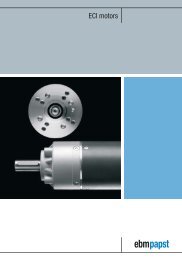
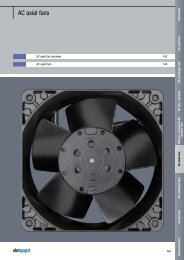
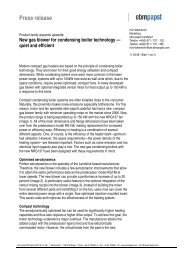
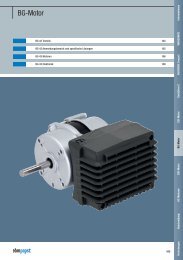
![ACmaxx GreenTech EC-compact fans [PDF] 2.0 MB - ebm-papst](https://img.yumpu.com/50068761/1/184x260/acmaxx-greentech-ec-compact-fans-pdf-20-mb-ebm-papst.jpg?quality=85)
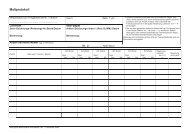
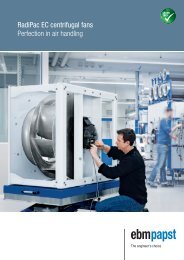
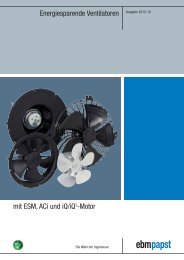
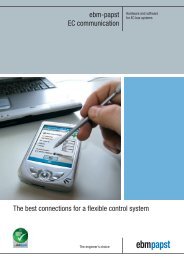
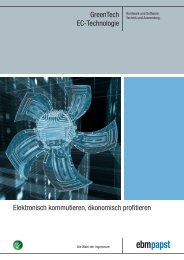
![DC axial fans 2011 [PDF] - ebm-papst](https://img.yumpu.com/48583495/1/184x260/dc-axial-fans-2011-pdf-ebm-papst.jpg?quality=85)
![Download [PDF] - ebm-papst](https://img.yumpu.com/47768780/1/184x260/download-pdf-ebm-papst.jpg?quality=85)
